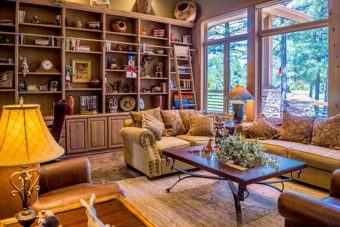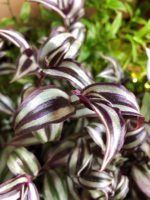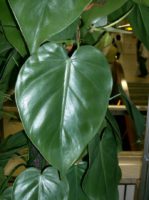In this article, we will be talking about ways of using houseplants to hide those feature in your home which you want other people to not see. We will also be discussing how houseplants can make an existing feature more attractive.

All homes either old or modern have some features that are best hidden or at least blended to the background; the home may have gas, water piping or electrical conduits that are clearly visible. These, of course, can be boxed in, but this can cause problems in the near future where maintenance or repairs have to be made and access is required.
Although unsightly pipes and cables are not often seen today but every home has a room which can do with brightening up, like a chimney breast, or an unsightly wall (that no matter what you do looks unattractive).
For these areas, it is better to use foliage plants that can be trained to grow over them, but you need to take care that the plant does not touch the hot water pipes, as it will surely kill it. This can be avoided by using pipe lagging but it is still better not to touch them, as this will make maintenance difficult, especially if the plant twines around the pipe or conduit.
USING TRAILING PLANTS AND CLIMBING PLANTS AS A SCREEN
Many climbing houseplants can be trained as a screen, such as Hedera canariensis ‘Variegata’ (Canary Island Ivy), Hedera helix ‘Chicago’, Rhoicissus rhomboidea (Grape Ivy), Philodendron scandens (Sweetheart Vine), and Cissus antarctica (Kangaroo Vine).
In hanging baskets, you can use the following trailers such as Scindapsis aureus (Devil’s Ivy) and its cousin Scindapsis aureus ‘Marble Queen’ that has variegated white-leaves. You can also use popular Tradescantias, especially Tradescantia zebrina with its colourful leaves.
BRIGHTEN UP YOUR WINDOW VIEWS
Few plants are brilliant in colour the whole year round and a window opening on a dreary outside view will benefit from a few plants placed in front of them, especially in winter where very few plants are colourful outside.

Of course, plants can be stood on the window sills, but you can add extra space by placing a shelf across the window. This will enable more plant to be housed and offer a better view.
The shelves often prevent the window from being opened and the whole display may need to be adjusted or removed in the summer months, where the outdoor views will be much more appreciated at that time. You can position trailing plants at either side of the top shelf to complement the look.
GIVE PURPOSE TO SMALL AND ODD SHAPED PLACES
Some homes, particularly old homes have odd-shaped rooms or narrow corridors that have no practical purpose. Narrow passages that have been blocked off can be turned into a pleasant are by using large foliage plants to act as a focal point, along with small shelves at the side to have a variety of small plants on,
If by choice, the area has a window along one side, then this area can be turned in a sanitary for plants that can barely survive dark corners in the other parts of the home. You can use mirrors at the end of the passage to reduce any feeling of claustrophobia.
SEASONAL IMPROVEMENTS OF BOX RADIATORS
Some people do not like the look of radiators and some people will box them in. Not much can be placed these boxes in winter when the radiator is in use, but with the arrival of summer, you can use the top of the box to place your plants on top of them. Trailing plants are ideal to cover the radiators in, but even if you do not have a radiator box you can use a board fitted above the radiator to place your houseplants on (when the radiator is not in use).
It is obvious to use trailing plants that will cover the radiator, but you can use one or two upright flowering plants that will capture the eye. Jasminum polyanthum in the centre with Persian violets (Exacum affine) either side, will create interest. To look more stylish it is best to place it in a deep-sided ornamental pot or dish on top of the radiator. It will certainly add extra panache to the look.
PLAY TRICKS ON YOUR EYE
Most rooms are not of perfect shape. Some are too high, whilst others are too long and narrow. For long and narrow rooms, it is best to use large foliage plants and hanging basket to divide the area of the room, or at least to distract the eye.

Victorian rooms tend to have high ceilings that often look imposing. To break this up you need your eye to capture a focal point that is relatively low in the room. In this way, your eyes will look down and not up.
Tall rooms are normally difficult to heat adequately in winter, but during summer they present a cool, light, airy atmosphere, that so often many houseplants will thrive in. This is a perfect room and opportunity to grow large palms and other large-leaved plants in.
CREATING FOCAL POINTS
All living/dining rooms need an area that will create interest and initially attracts the eye too. The trouble with modern centrally heated homes is that the focal point of the fireplace has disappeared, having the room itself as the only form of interest.
In these rooms, a collection of plants can be used, some large and permanent, whilst others will be temporary, including colourful plants when it is needed.
Once finished flowering the plants can be moved around and be replaced with other colourful plants.
The plants can be integrated with an attractive piece of furniture. You are not chained to using one wall to place your houseplants, but you can use one corner or the opposite end of the room where the window is placed. To help in this regard, you can use mirrors strategically placed in the room, reflecting light onto the plants.
ENHANCING GOOD FEATURES
CAPTURING ATTENTION
Arches, window surrounding and unused fireplaces are few areas in the room that can be beautified and enhanced by houseplants. For instance, small windows high up in walls will benefit from using trailing plants, such as the blue-flowered Campanula isophylla and ivies. For those who blue will clash with the décor, you can use a white form of the same plant. Easy to look after, demanding little attention, but water and the removal of dead flowers.
Small windows can be enhanced and so can large picture and French windows by using houseplants. To take your eye to large windows, the boring uPVC frames can be camouflaged with climbing foliage plants, such as the Grape Ivy (Rhoicissus rhomboidea).

In an average pot, this plant can grow up to 1.2m but if given a large container it will continue to grow up to the ceiling, even in high rooms. It clings to a framework by means of tendrils, displaying it dark green shiny leaves formed of three-slotted diamond-shaped leaflets.
Other climbing foliage plant can also be used including the Cissus antarctica (Kangaroo Vine) and Philodendron scandens with their attractive dark, green heart-shaped leaves.
If you are looking for variegated leaves then Cissus discolor can be used with triangular, vivid green leaves with purple undersides and white and purple markings on top make an attractive addition to any home. The plant does like high temperatures and may drop some leaves during winter. If the area is cold, the ever-reliable Hedera canariensis ‘Variegata’ can be used.
PLANTS IN ALCOVES
The small recessed area can be effectively used to display plants, especially so if the area is illuminated. If the alcoves have a rounded top with a conceal line the plants will look even better. It is best not to overcrowd these areas with plants, just one plant per alcove.

Ferns take kindly to these areas, where the Nephrolepsis exaltata ‘Bostoniensis’ (Boston Fern) or Adiantum raddianum are the preferred specimens to grow. These plants have a spreading and somewhat trailing look to the fronds, which are ideal for placing on a glass shelve placed 2/3 up the alcove.
If a small cupboard is placed at the bottom of the alcove, then the plants to use are ferns that are best admired from above such as Asplenium nidus (Bird’s Nest Fern) or Pellaea rotundifolia (Button Fern).
You can also place palms, especially Chrysalidocarpus lutescen (Areca Palm) that does not fail to impress, with its bamboo-like stems and glossy, yellow-green leaves.
BEAUTIFYING ARCHES
Sometimes sitting and dining area are separated by arches or beams across the room. Arches with their attractive curved side can be enhanced by setting plants in wall plant holders around the room near the arch, which will give more of a natural appearance.
It would be a mistake to clutter such a small area with too many houseplants. It is best to use a wall-mounted, small-leaved, variegated ivy at each side to make the arch look more interesting, but at the same time does not intrude on the lines of the arches.
On the dining area side of the arch, you should change the theme by the use of climbing foliage plants that can be allowed to grow around the arch.
ENHANCING FURNITURE
Sometimes pieces of furniture with large polished surfaces can have their attractiveness improved on by using containers and plants that harmonise with them. Copper and brass indoor containers will produce a warm appearance, especially when combined with mound-forming foliage plants, such as Begonia bowerae. It has small, emerald green leaves that have chocolate blotches on top of the leaves.
Containers with low-height tend to look better. With furniture, it is best not to use plants that dominate the area, as this will detract attention from the piece of furniture, instead use plants that will blend and complement the area with the pieces of furniture.
CONCLUSIONS
In this article, we have discussed the best ways to use houseplants to hide unsightly features and able to highlight good features. You can use plants to hide cabling, pipework, awkward shaped room and around windows, The importance of creating a focal point has been highlighted.
Areas that are unutilised such as an old fireplace, unused corners, alcoves and arches can all be brightened up by using houseplants placed strategically on these areas.
Houseplants have many practical uses in the home and can achieve much more than people can envisage. They are not only there to look good but they are there to hide a multitude of sins.
If you have any questions to raise or comments you want to make, please do so in the comment box below.
Cover your mistakes with houseplants.

Hello, Antonio
I always enjoy reading your articles as you have lots of useful advice.
I am new to both gardening and looking after house plants.
I’ve recently moved into my first home so I’m on the look-out for inspiration.
My house is fairly new so has no interesting alcoves or pipe work that needs to be concealed but I do have wide window sills which would benefit from the addition of interesting house plants. I’m not sure what to buy yet but I will have a look on my next visit to the garden centre. Would I need to move the plants when the weather gets colder?
Best wishes,
Cameron
Hi Cameron
it is my pleasure to help you become a better gardener. I am also learning as well a scin writing thesexarticles I am discovering new things, which I can tell people about. Houseplants are a great addition to any home as they bring so much beauty. In general, if you are using central heating houseplant do not need to move. Most houseplants do not do well if the temperature drops below 10 degree Celsius.
Thanks
Antonio
Overtime plants has really been a good option when it comes to decorations as they not only hide some details but ultimately the help in spelling out certain features of the properties around them…for me I think house plants are the best agent it comes to indoor decorations.tjanks a lot for sharing.
Hi Ismeglamour
I thank you very much for stopping by and commenting. I really believe it is important to use houseplants wisely into not only hide ugly structures in the home but it can be used to enhance them as well. A home full of beautiful plants simply look stunning.
Thanks
Antonio
Looks like there are many different ways to use the home plants in our houses rather than just using them to make money but selling them. You know, I didn’t think that the beauty of the flowers could also be used to cover up some unwanted sights too. One if the best ideas I see here is the one about the corners and about the view from the window. I’ll be trying those out in my home too. Thanks.
Hi Payton
Thank you very much for those kind words, as I try to get gardeners to think about their situation. In this case I want people to see that houseplants can be a useful asset in the home. I am glad you are taking this and adsptungbit to your home.
Thanks
Antonio